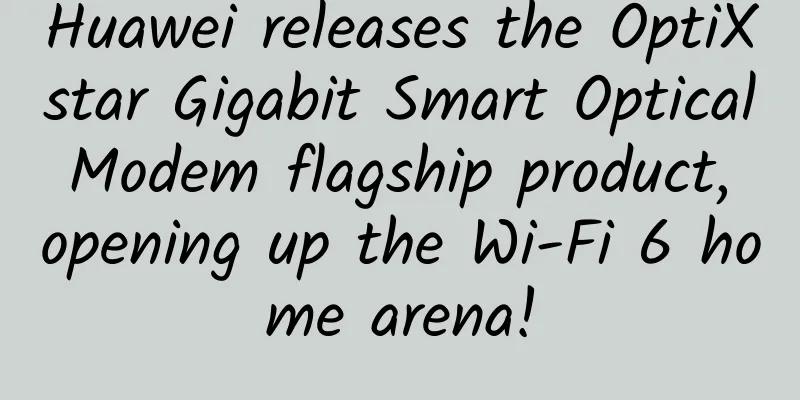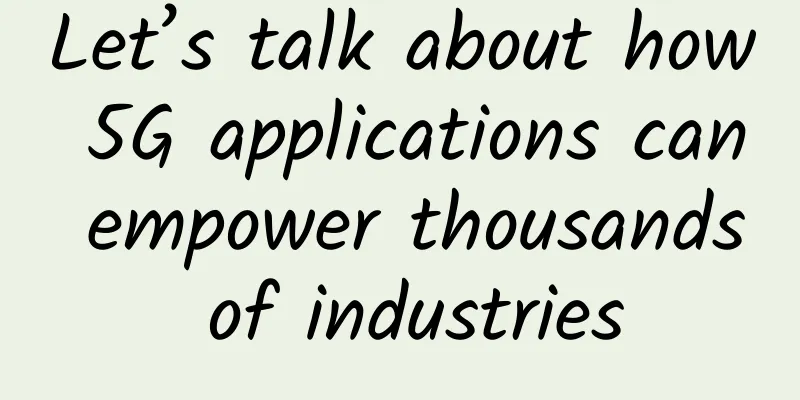Huawei releases the OptiXstar Gigabit Smart Optical Modem flagship product, opening up the Wi-Fi 6 home arena!

|
[51CTO.com original article] On March 30, Huawei officially released the industry's first Gigabit smart optical modem OptiXstar series, based on innovative 10G PON, eAI (embedded artificial intelligence) and Wi-Fi 6 technologies, to reconstruct the home broadband experience and accelerate the popularization of Gigabit home broadband. At the press conference, Zhou Jun, President of Huawei's access network domain, revealed to the media how Huawei brings people a completely different home broadband experience through technological innovation. After the live broadcast of the press conference, Feng Zhishan, General Manager of Huawei's Home Network Domain, also accepted an interview with the media, elaborating in detail on Huawei's ideas and vision behind creating quality home broadband. Technology "magic operation" breaks the three major problems of traditional home broadband Zhou Jun said that many families now have 100M bandwidth installed, but in a survey of 2,500 broadband users, the actual network experience is not very good, and slow network, lag, and disconnection have become the three main problems that are criticized. So can these problems be solved by technical means? Huawei's answer is yes. Let’s take a look at how Huawei performs its magic! Zhou Jun introduced that in terms of speed, Huawei uses self-developed high-performance chips and adopts a 160MHz bandwidth design. During the actual speed test, the bandwidth can reach 1.6G to 1.8G, and through spectrum aggregation technology, the utilization rate of the WI-FI spectrum is increased by 50%, which can turn the bandwidth into a "dual lane" and will not affect multiple concurrent services. In terms of latency, Huawei achieves specific acceleration for key broadband services through unique embedded intelligent AI recognition technology, air interface slicing technology, and WI-FI6 anti-interference technology. For example, for the currently popular "Suspended Classes but Not Learning", Huawei has cooperated with well-known domestic educational institutions to test the acceleration effect on the actual online network, which can achieve zero lag in 25-minute online classes, and home VR cloud games can also be enjoyed freely. In terms of penetration, Huawei uses high-gain antennas and high-quality Wi-Fi algorithms, which can allow Wi-Fi signals to penetrate one more wall and achieve full Wi-Fi signal coverage throughout the house. Through high-gain 5dBi dual-beam antennas and intelligent power control algorithms, coverage is truly enhanced by 25%, solving the problem of Wi-Fi coverage in home environments. In addition to the above, Huawei has also introduced the Huawei Intelligent Operation and Maintenance Platform, which supports one-click diagnosis of problems and automatic fault repair. On the one hand, it solves the urgent needs of users in broadband services, and on the other hand, it reduces the number of on-site repairs by operators and saves labor costs. In addition, it is worth mentioning that Huawei's flagship products also provide end-to-end four-level security protection, allowing children and family members to enjoy broadband services without worries. Huawei has also taken energy consumption into consideration. It is reported that Huawei uses intelligent dynamic energy-saving design to help each optical modem reduce its power consumption. Huawei's optical modem intelligent sleep technology can save each user 38 kWh of electricity per year, and the carbon emissions saved are equivalent to planting one more tree each year. Will be introduced to the market through telecom operators, bandwidth will no longer be "discounted" Feng Zhishan told reporters that Huawei's optical modems are currently being promoted to the consumer market mainly through the three major telecom operators in China. Consumers can enjoy the new experience of Wi-Fi 6 by applying for a gigabit broadband package from telecom operators. He also revealed that this year, the entire Wi-Fi 6 optical modem will enter a large-scale deployment state to solve the end-user experience problem. The three major operators are currently making active preparations on this basis. Huawei believes that the centralized optical modems will also integrate the features of Wi-Fi 6, allowing the Wi-Fi 6 experience to allow the public to truly enjoy the convenience of high bandwidth and high speed, and solve the problems encountered in online education, gaming, and cloud travel. When talking about the market, he also added that there are currently a large number of Wi-Fi 4 optical modems on the market, which cannot meet the needs of packages above 100 Mbps. The Wi-Fi 5 optical modems previously released on the market are mainly compatible with 200 Mbps. The Wi-Fi 6 optical modems released by Huawei this time are mainly compatible with packages of 300 Mbps to 1000 Mbps, or even more than 1000 Mbps. "The user's experience will be as high as the bandwidth he signed up for, and the actual bandwidth will match the package standard without any discount. This is exactly the goal of Huawei's release of the Gigabit optical modem." Of course, if consumers want to get the Wi-Fi 6 experience, they must adapt from end to end. In addition to optical modems, manufacturers in the fields of mobile phones, tablets, and TVs have announced support for Wi-Fi 6, and Huawei Terminal has just released the P40 mobile phone that supports Wi-Fi 6. These increasing number of Wi-Fi 6 terminals will in turn promote the accelerated deployment of Wi-Fi 6 optical modems, which is why Huawei released Wi-Fi 6 optical modems in 2020. "Huawei will continue to innovate in the future. With the evolution of optical modems, technological innovations, and improved user experience, we believe that Huawei will develop more abundant new products and new features to allow end consumers to experience the changes brought about by the network and support their business needs." [51CTO original article, please indicate the original author and source as 51CTO.com when reprinting on partner sites] |
Recommend
Sharktech: $129/month high-defense server, 2*E5-2678V3/64GB/1TB NVMe/1Gbps unlimited traffic
Sharktech is a shark computer room (or SK compute...
The story of spectrum: Gigabit is just the beginning
At the end of 4G development, the most advanced m...
Combining VXLAN and EVPN
EVPN is one of the hottest network technologies i...
Talking about HTTP connection related knowledge
[[374909]] This article will first introduce the ...
What is blockchain fork? I finally understand
I have previously written about how Bitcoin minin...
Application of multimodal algorithms in video understanding
1. Overview At present, video classification algo...
UFOVPS Spring Festival 50% off, top up 200 yuan to get 30 yuan, Japan/Hong Kong CN2 GIA/US high-defense VPS monthly payment starts from 19 yuan
UFOVPS has launched a special promotion for the S...
3 Tips to Learn Network Technology
Computer network course is an important basic cou...
Edge user performance improvement solution based on multi-point coordination CoMP
1. Project Background The 5G communication networ...
Smart city becomes the new name card of Lanzhou New District: new momentum for the new district breeds new development
[51CTO.com original article] Not long ago, the 20...
SD-WAN in 2019: A conundrum for service providers
It’s that time of year again when analysts and ex...
Maxthon Hosting: Unpopular CN2 Data Center, German CN2/Netherlands CN2 (Anti-complaint), 2G memory package starting from 60 yuan per month
In January, we shared the news about Maxthon'...
JustVPS: 30% off UK VPS/20% off all VPS, unlimited traffic in multiple data centers in the United States/France/Singapore/Russia/Hong Kong, China
JustVPS.pro bought a VPS in London, UK, last Dece...
Roaming on different networks is "running fast", can breakthroughs in standards open the door to a new world?
The Ministry of Industry and Information Technolo...
Wireless communication technologies within reach in daily life - WiFi, Bluetooth and NFC
WiFi Wi-Fi (Wireless Fidelity) is a wireless LAN ...



![[6.18] Eurasia Cloud: Los Angeles CN2 GIA line VPS quarterly payment starts from 56.8 yuan](/upload/images/67cabe93dbfe8.webp)





